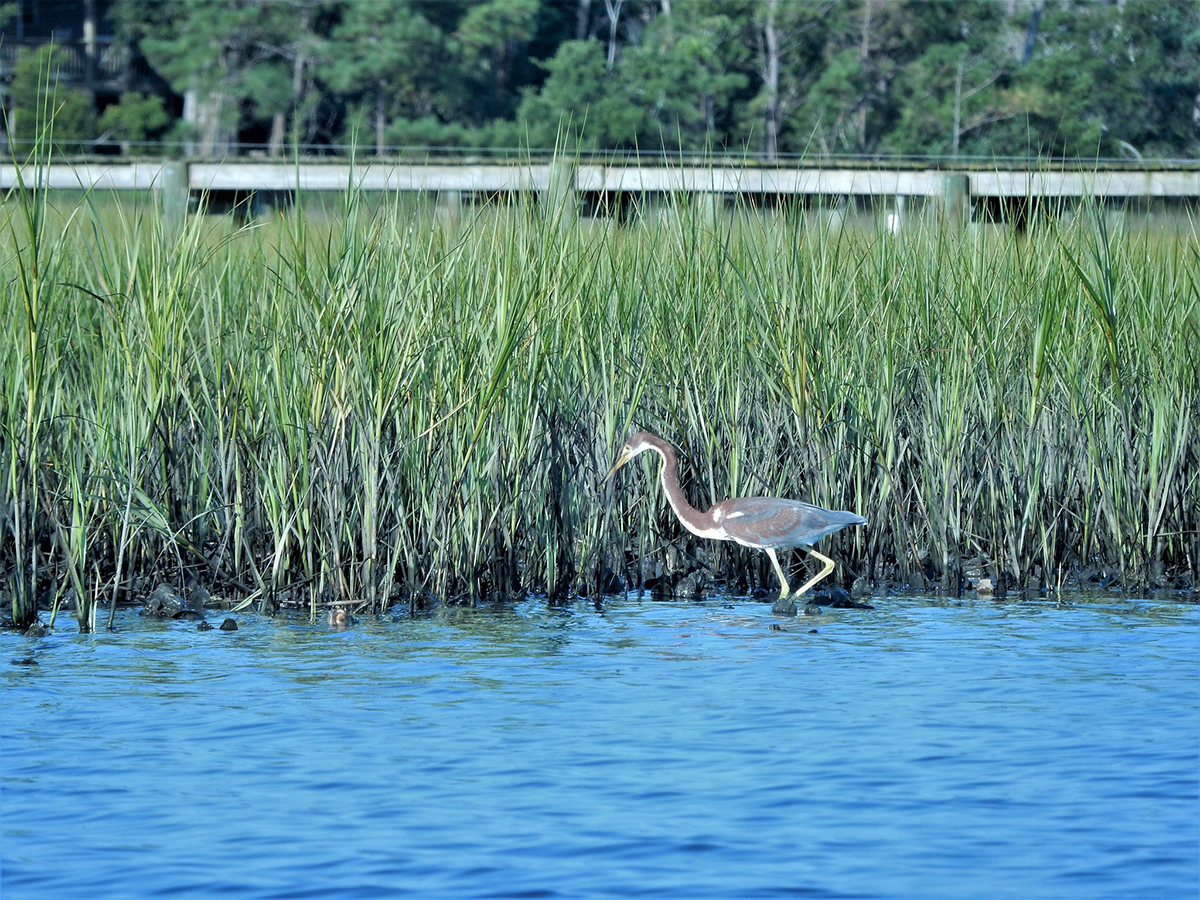
Natural solutions, voluntary, incentivize — these are some of the ways suggested by a stakeholder workgroup to enhance and protect North Carolina’s coastal waters.
In all, 10 recommendations in Appendix A from the workgroup have been tacked on to the Coastal Habitat Protection Plan approved for public review by the three regulatory commissions with oversight on coastal issues.
Supporter Spotlight
“The goal was to identify and make recommendations on actionable nonregulatory strategies for improving and protecting water quality to safeguard fishery habitats,” said Leda Cunningham, The Pew Charitable Trusts officer.
The proposal of a workgroup was born out of the Jan. 21 meeting of the CHPP Steering Committee when committee chair Martin Posey raised the idea to form a group that would come up with recommendations with a focus on water quality-related issues that could quickly be accomplished, according to the minutes of that meeting.

Pew and the North Carolina Coastal Federation stepped up to the offer, assembling a group of nine stakeholders with expertise in farming, fishing, wetland and water quality mitigation practices, land development, local governments, environmental programs, laws and regulations, environmental engineering and management, and property management. The federation publishes Coastal Review.
“My input was not necessarily technical in nature, but my input to it was that I like the nature-based approach rather than the heavy-handed regulatory approach,” said Pine Knoll Shores Town Manager Brian Kramer, one of the nine stakeholders in the workgroup. “There’s solutions that aren’t necessarily simply regulatory-based. What that means to me is that there may be solutions that are presented right now in terms of infiltration or in terms of simple design changes that’s not necessarily anti-development, but pro-nature. If you can find a way to take advantage of what we already have to protect the water quality and such then those options should be explored.”

The Bogue Banks town in Carteret County recently completed an innovative stormwater project using recommendations from the Coastal Federation, using infiltration methods in more heavily flooded areas of town.
Supporter Spotlight
There’s also discussion among members of the town board about putting out public education initiatives on downspout management.
“What’s interesting to me is the degree to which everything ties together as far as impacts of man on nature,” Kramer said, adding that he both fishes and duck hunts. “When you lose (seagrass) you lose fish, you lose the things that grow and nurture, and that impacts wildlife.”
The workgroup’s meetings included North Carolina Department of Environmental Quality staff working on the CHPP, and three scientists whose expertise is in water quality and seagrass, Cunningham said.
The CHPP was first adopted in late 2004 by the state’s three regulatory commissions with oversight on coastal issues: the Environmental Management Commission, Coastal Resources Commission and Marine Fisheries Commission.
The goal of the plan is to protect, restore and conserve coastal habitats that sustain coastal fisheries. It identifies six coastal habitat types: wetlands, submerged aquatic vegetation, marshes, soft bottom, shell bottom and water column, which is the space between the water’s surface and the bottom.
The plan is reviewed every five years by environmental officials within DEQ, the divisions of which must work together to implement the recommendations set forth in the CHPP.
This year, the focus is on specific issues, identifying concerns related to those issues, researching ways to mitigate the impacts of those issues on coastal habitats, and using that research to implement rules and regulations to reduce those impacts.
The end result is an amendment to the CHPP that includes a series of issue papers addressing submerged aquatic vegetation, wetland protection and restoration through nature-based solutions, environmental rule compliance, wastewater infrastructure solutions for water quality improvement and coastal habitat mapping and monitoring.
“The group recognized that in several of the priority issue papers that were in the CHPP that water quality was kind of a cross-cutting theme so the idea was to provide tangible, measurable things that this group of stakeholders could not only identify as strategies, but could also help implement,” Cunningham said.
The workgroup’s recommendations are designed to help expand and engage public participation in implementing the CHPP, she said.
Those recommendations include the following:
- The CHPP Steering Committee and DEQ form a public-private partnership working with stakeholders to further refine and implement the strategy in 2022, as well as evaluate and refine the strategy as it’s used.
- Ask the state’s governor to issue an executive order directing state agencies to work with the steering committee, DEQ, business, industry, agriculture, federal agencies, nongovernment organizations, universities, North Carolina Water Resources Research Institute, North Carolina Sea Grant, and local governments to implement water quality actions that control and reduce nutrient, sediment, pathogen, and other pollutant loadings in coastal estuaries and, when possible, align those actions with statewide climate resiliency strategies.
- Expand financial incentives and technical assistance to encourage communities to voluntarily create and routinely update local watershed management plans.
- Focus and prioritize General Assembly-funded plans and stormwater retrofits to ensure the protection and restoration of coastal fish habitats.
- Support and promote financial incentives program encouraging public and private waterfront property owners to install living shorelines to mitigate shoreline erosion and naturally treat and reduce runoff.
- Promote the use of nature-based stormwater practices through state-funded construction in coastal counties and river basins that flow to coastal habitats.
- Create and implement a voluntary submerged aquatic vegetation protection and restoration plan for Bogue Sound.
- Encourage the state Department of Transportation and municipal transportation agencies to adopt nature-based stormwater strategies for the highways the build, design and maintain.
- Expand access to financial and technical cost-share assistance and incentives that help landowners, farmers, foresters, U.S. Department of Defense, and other property owners to protect coastal fishery habitats.
- Prioritize nutrient management as a coastal habitat protection strategy to protect and restore the health and productivity of coastal estuaries.
Cunningham and others praise the proposed CHPP amendment.
“What we do to help water quality has positive benefits and positive impacts on habitat as well,” Cunningham said. “Because severe weather, rising sea levels, and increased human use of resources, it really is more important than ever to pursue durable strategies that ensure their long-term health and sustainability. Not only does North Carolina have really special places on the coast, we have really incredible opportunities for people that want to protect and restore those places to work together and the CHPP is really the blueprint that pulls it all together.”
Next month is expected to kick off a series of meetings to accept public comment.
The meetings, which will be held by web conference, will be scheduled in conjunction with five Marine Fisheries Commission advisory committee meetings. The dates and times of those meetings, links to the web conference, as well as an online survey will be announced in a news release in the next couple of weeks, according to a N.C. Division of Marine Fisheries spokesperson.
Once public comment period ends for the draft CHPP amendment, the plan will go back to the three commissions in November for final approval. If approved, the CHPP will then go to the Joint Legislative Committee on Governmental Operations.
The amendment may be adopted by year’s end or early next year.







